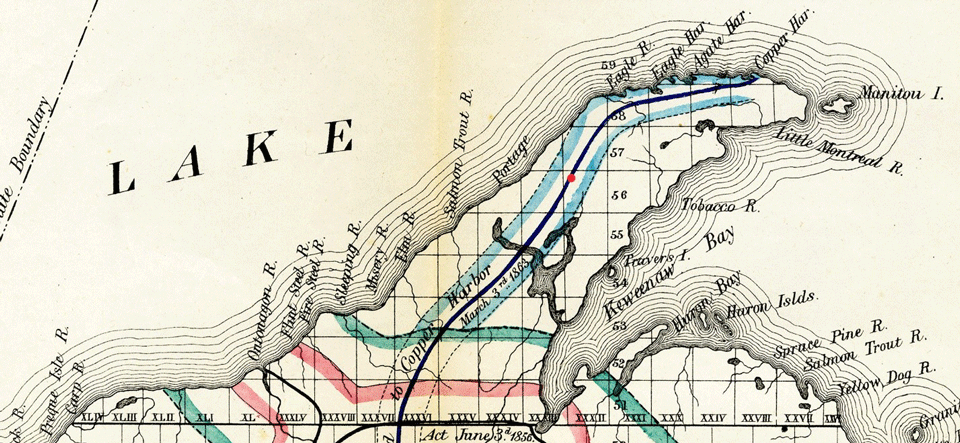
Sketch of the public surveys in Michigan, Julius Bien, New York, General Land Office. 1865, NPS edits 
18th November 1904, Fri - Page 1 While a stagecoach road was under construction from Hancock to Eagle River during the Civil War, African-American entrepreneurs Larkin J. and Eunice A. (Williams) Jones built a stagecoach inn or “half-way house” near the Houghton/Keweenaw County Line. On land they would buy from the St. Mary’s Canal Land Company, the couple began operations at their licensed hotel and saloon around 1863.
At least two published accounts relating the discovery of the Calumet Conglomerate include mentions of the Jones’ already active business. Richard Tregaskis related many years later that in 1863 he had,“started on horseback over a rough corduroy road, through dense, woods, cedar swamps and maplebrush, and stopped for a dinner at the Half-Way house, kept by a colored man named Jones.” Tregaskis then encountered the lode’s discoverers, and returned to the Half-Way house to borrow a pick and shovel in order to make a thorough examination. The Calumet Conglomerate would prove itself to be the Copper Country’s most profitable copper-bearing lode, although the exact circumstances of its “discovery” in the 1850s or 1860s has become obscured by time. Eunice Jones passed away unexpectedly at the half-way house in 1864 at the age of 34. A few months later, Larkin Jones remarried to Anna Ward Covington. Anna was a widow of African descent who hadbeen living in Houghton with her young daughter, Gertrude. Together, Larkin and Anna had another daughter, Hattie. Larkin worked as a barber according to census records, while Anna operated the inn. The Jones’ marriage was in trouble by late 1870. Larkin left the household, and Anna advertised in nearby newspapers that lots for houses were for sale in the Village of Renova, a community forming on the Jones property. While most Keweenaw County mines saw fewer travelers following the Civil War, the Allouez and Kearsarge mines near the county line became active. Reflecting its business, the half-way house became a miners’ boarding house and saloon with Anna as its keeper. 
Red Jacket, Houghton County, Michigan. 1900 Sanborn Fire Insurance Company. NY. p28 Library of Congress. NPS edit. To learn more about this family and the sister of Eunice Williams Jones: Asa Jeffrey Microhistory |
Last updated: June 19, 2022
